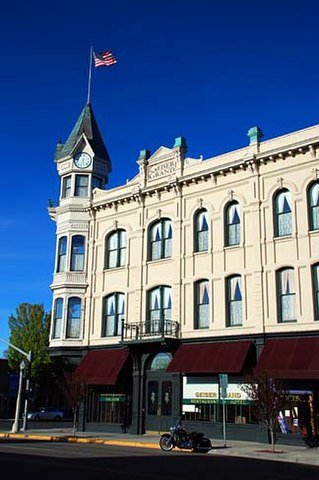Date of Establishment
The Geiser Grand Hotel was originally opened in 1886 in the height of the gold frenzy in Oregon. The Grand still operates to this day even after a few reopenings and change of owners, the latest of which was in 1993.
Name/Name & Location
The Geiser Grand Hotel opened in Baker City, Oregon, which was known as the “Queen City of the Mines,” due to the Gold Rush happenings within the region. The hotel also became known as “the Grand” for short because of the advanced technology and beauty it held within its walls.
Physical Description

An Italianate building containing technology that was ahead of its time: an elevator, a 4th story clock tower, a 200-foot corner cupola, a 2nd-floor balcony overlooking marble floors, crystal chandeliers, Honduran mahogany paneling, and stained-glass ceilings. All of these components made this hotel a grander of its time for all the wealthy and high society figures to flock to.
The Lady in Blue was also known as “Granny” Annabelle, a beautiful Victorian woman dressed in a blue gown is one of the hotel’s most known spirits. She was a permanent character making grand entries down from her room 302 and having her own reserved chair at the bar each night.
Origin
Opened in Baker City the hotel has stood for years and in 1906 was named the “the most fortunate place in the country” by a newspaper article. Ever since it’s 1902 reopening The Lady in Blue was a prominent figure at the Grand, which lead to the first tales of ghosts roaming the grounds after her death.
Mythology and Lore
The Lady in Blue has been a staple of siting’s at the Grand, multiple people have reported seeing her descending the staircase, sitting at the bar, and disappearing into the wall through-out the hotel. She is suspected of moving guests’ jewelry and items, nibbling snacks from their rooms, or down at the bar pinch the rears of those who sit in her chair. There are other well-known spirits to call the Grand home as well. There is a saloon girl in a red laced bustier who hangs about the balcony, a cowboy who chats with bar-goers, a little girl wandering the 3rd floor, and flappers from the 1920s. Many of the guests and workers have reported wide-ranges of experiences with the ghosts of the Grand, as well as paranormal groups who investigate the hotel regularly. Ghost Hunters and Atlantic Paranormal Group (TAPS) are two teams that see the Grand regularly and continue to collect data and do studies on the building and its spirits. The Grand also does daily ghost tours at the hotel to educate and tell the tales of the ghosts that stay at the Grand.
Modern Pop-Culture References
Books & Literature
Coast to Coast Ghosts: True Stories of Hauntings Across America (2012) page 156
Television Series
Ghost Hunters (2013 Season 2 Episode 5)
Is there anything we missed about Geiser Grand Hotel? Let us know in the comments section below!


